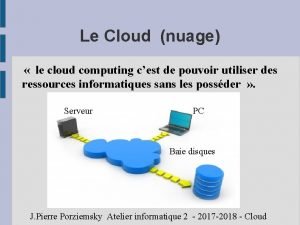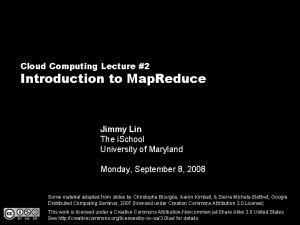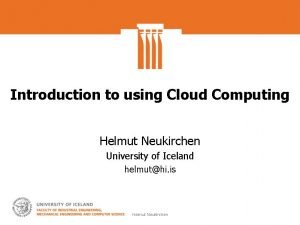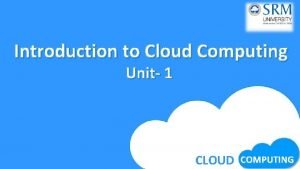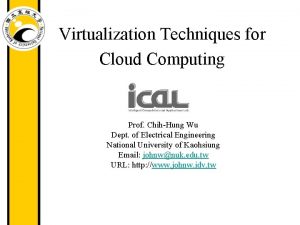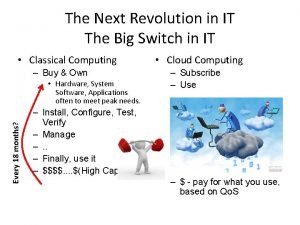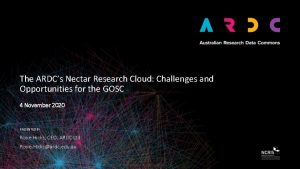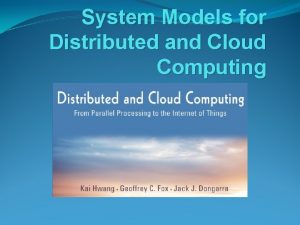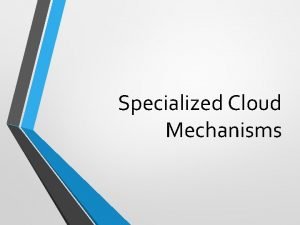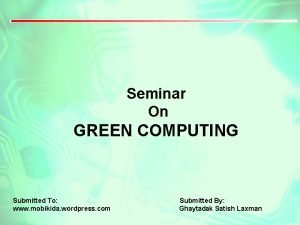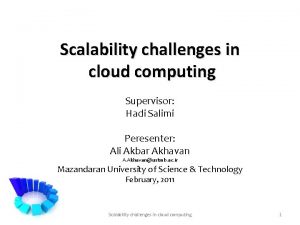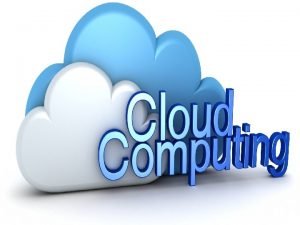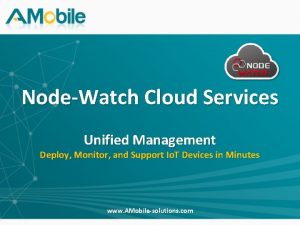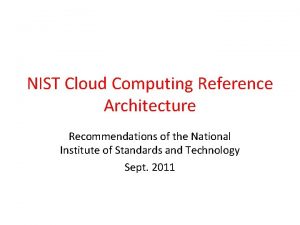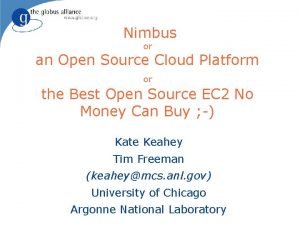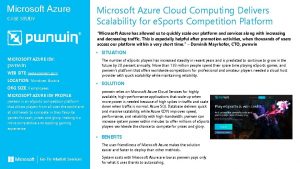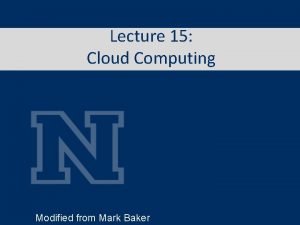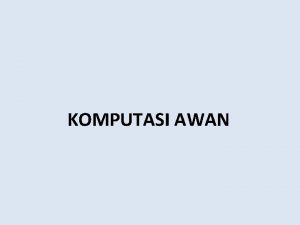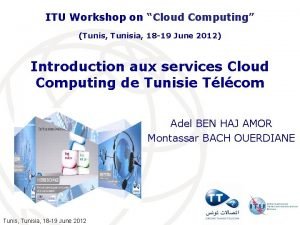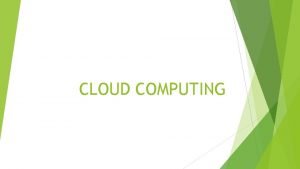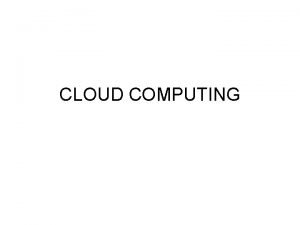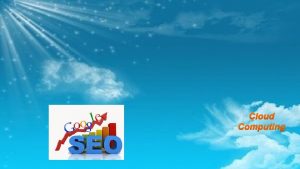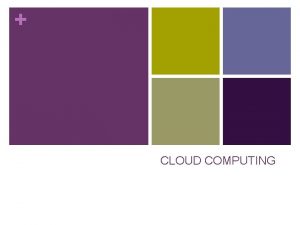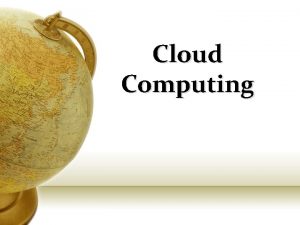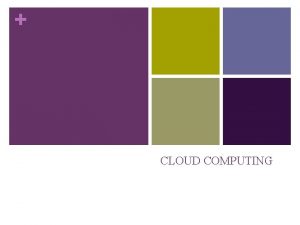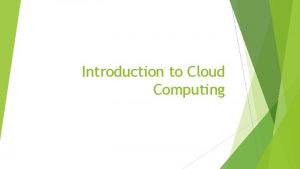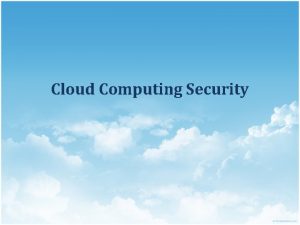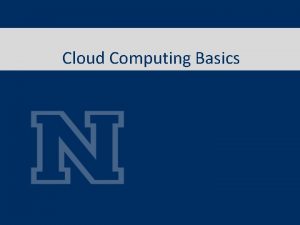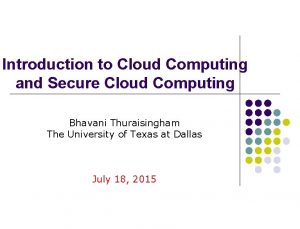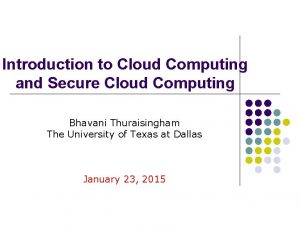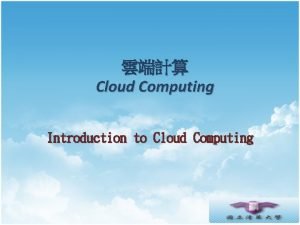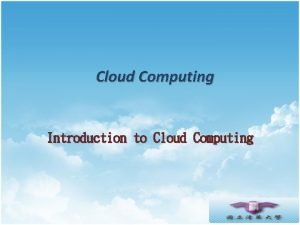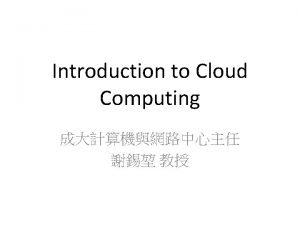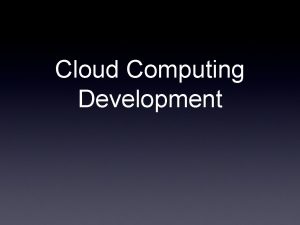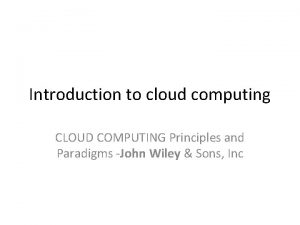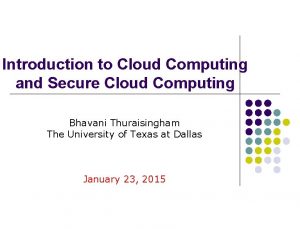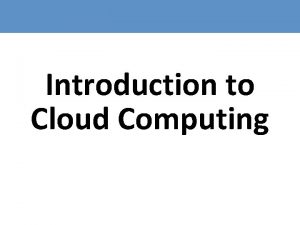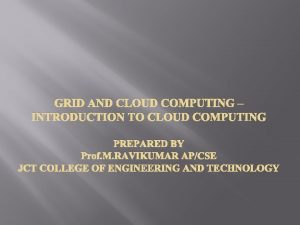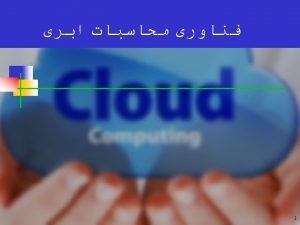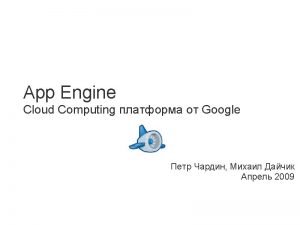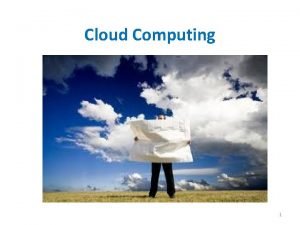INTRODUCTION TO CLOUD COMPUTING CLOUD The expression cloud


























- Slides: 26

INTRODUCTION TO CLOUD COMPUTING

CLOUD § The expression cloud is commonly used in science to describe a large agglomeration of objects that visually appear from a distance as a cloud § It describes any set of things whose details are not inspected further in a given context.

DEFINITION OF CLOUD COMPUTING § Cloud computing is computing in which large groups of remote servers are networked to allow the centralized data storage, and online access to computer services or resources.

ARCHITECTURAL MODEL

CLOUD COMPUTING SERVICES § Iaa. S: Infrastructure as a Service § Virtualized OS, fundamental hardware and software § Paa. S: Platform as a Service § Google API, web application services § Saa. S: Software as a Service § Dropbox, Gmail § Daa. S: Data as a Service § UN Data, “Bottle water” vs “plumbing”

CHARACTERISTICS OF CLOUD COMPUTING § On-demand self-service § Automatic service for customers § Broad network access § Across different systems (e. g. , desktops, mobile phones) § Resource pooling § Consolidating different types of computing resources

§ Rapid elasticity § Quickly provisioning, allocating, releasing computing resources § Measured service § Supports “pay-as-you-go” service

SERVICE ORCHESTRATION

ACTORS IN CLOUD COMPUTING § Cloud Consumer § Cloud Provider § Cloud Auditor § Cloud Broker § Cloud Carrier

CLOUD CONSUMER Saa. S § Directly use software or provide members with access § Document management, HR, billing, social networks Paa. S § Develop, test, deploy, manage applications § Databases, business intelligence, applications Iaa. S § Access to virtual computers, storage, network infrastructure § Used for backup/recovery, storage, platform hosting

CLOUD PROVIDER Acquires computing infrastructure, runs cloud software, delivers services through network. Saa. S § Deploys, configures, maintains software applications § Responsible for most of application control, management Paa. S § Manages infrastructure, runs cloud software § Supports application deployment, development through software development kits (SDKs) Iaa. S § Acquires physical computing resources, runs cloud software (host OS, storage devices, network equipment, etc. ) § Consumer takes over more fundamental computing resources like OS and network


CLOUD AUDITOR § Evaluate in terms of security controls, privacy impact, performance, etc. § Ensure confidentiality, integrity, and availability

CLOUD BROKER § An entity that manages the use, performance and delivery of cloud services § Able to negotiate relationships between cloud providers and cloud consumers Provide three category of services • Service Intermediation • Service Aggregation • Service Arbitrage

CLOUD CARRIER § Provides connectivity and transport of cloud services between cloud consumers and cloud providers.


GEOSPATIAL CLOUD SERVICES § Iaa. S § Geospatial modeling § Allows for control over computing resources § Paa. S § Best for parameter extraction § Examples: Vegetation index, sea surface temperature

§ Saa. S § Arc. GIS Online § Knowledge and decision support § Used by experts, managers, or public § Daa. S § Earth Observation data access, storage and processing

TAXONOMY OF CLOUDS § Public Cloud § Private Cloud § Community Cloud § Hybrid Cloud

PUBLIC CLOUD § The cloud infrastructure and computing resources are made available to the general public over a public network.

PUBLIC CLOUD Examples § Amazon Elastic Compute Cloud (EC 2) § IBM’s Blue Cloud § Sun Cloud § Google App. Engine § Windows Azure Services

PRIVATE CLOUD § For a single Cloud Consumer’s organization § Exclusive access given to usage of the infrastructure and computational resources.

COMMUNITY CLOUD § A group of Cloud Consumers which have shared concerns (e. g. mission objectives, security, privacy and compliance policy)

HYBRID CLOUD § A composition of two or more clouds § These clouds are bound together by standardized or proprietary technology that enables data and application portability.


REFERENCES § Liu, F. , Tong, J. , Mao, J. , Bohn, R. , Messina, J. , Badger, L. , & Leaf, D. (2011). NIST cloud computing reference architecture. NIST special publication, 500, 292. § Yang, C. , Raskin, R. , Goodchild, M. , & Gahegan, M. (2010). Geospatial cyberinfrastructure: past, present and future. Computers, Environment and Urban Systems, 34(4), 264 -277.
 Which computing refers to applications and services
Which computing refers to applications and services Regarder introduction to cloud computing
Regarder introduction to cloud computing Introduction to mapreduce in cloud computing
Introduction to mapreduce in cloud computing Introduction to cloud computing
Introduction to cloud computing Introduction to cloud computing
Introduction to cloud computing A quadratic expression is an expression of
A quadratic expression is an expression of Conventional computing and intelligent computing
Conventional computing and intelligent computing Vodafone cloud service hosting
Vodafone cloud service hosting Virtualization techniques in cloud computing
Virtualization techniques in cloud computing Virtualization tools and mechanisms in cloud computing
Virtualization tools and mechanisms in cloud computing A type of cloud
A type of cloud Cloud computing reference model
Cloud computing reference model Ardc nectar
Ardc nectar All resources are tightly coupled in computing paradigm of
All resources are tightly coupled in computing paradigm of Automated scaling listener
Automated scaling listener Green cloud computing ppt
Green cloud computing ppt Scalability issues in cloud computing
Scalability issues in cloud computing Cloud conclusion
Cloud conclusion Cloud unified management
Cloud unified management Nist architecture in cloud computing
Nist architecture in cloud computing Nimbus cloud computing
Nimbus cloud computing Cloud computing cambridge
Cloud computing cambridge Case study on microsoft azure in cloud computing
Case study on microsoft azure in cloud computing Cloud computing layers
Cloud computing layers Sejarah cloud computing
Sejarah cloud computing Headless cms kentico
Headless cms kentico Cloud computing tunisie
Cloud computing tunisie

